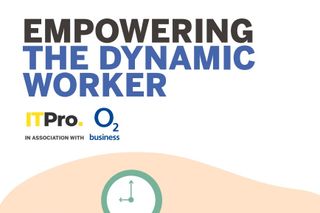Why you should prioritise employee experience
How your employees perceive your organisation is key to business success

An organisation is only as good as its employees. Ensuring that both your current and potential employees view your company in a positive light is vital to talent recruitment, retention and productivity.
Putting your staff first is not just the right thing to do, it makes business sense. A recent Gartner survey found that 64% of HR leaders are making employee experience a bigger priority as we emerge from the coronavirus pandemic and return to work. Elisabeth Joyce, vice president of advisory in the Gartner HR practice, noted that “the return to the workplace is not just an operational challenge, it’s a human challenge".
Post-pandemic, with work trends poised to shift to a more permanent hybrid model, it's more important than ever for organisations to look at how they manage their staff.
One key way to improve employee experience is by investing in the right technology. By arming your workforce with the tools to do their jobs effectively, and creating the right tech-driven environment, you'll aid productivity and make them feel better about their day-to-day experience with you.
What is employee experience?
Employee experience, put simply, encompasses all the perceptions and feelings staff have about their interactions with your organisation while working for you. Many leading companies look to improve the employee experience as a whole to ensure staff feel supported and that the company culture, and their working environment, are enjoyable.
It’s not about the employee benefits staff can enjoy, like travel concessions or other perks, it’s about all aspects of the company that have an impact on your employees day. From the office layout to the flexible working policy, it’s ensuring your company provides the best conditions to shape a positive perception and allow staff to give their best.
Why is prioritising employee experience important?
From the start of their working relationship with your organisation, and even new candidates yet to begin working for you, employees are considering everything that happens at work and how this affects their daily lives, physically, emotionally and financially.
Get the ITPro. daily newsletter
Receive our latest news, industry updates, featured resources and more. Sign up today to receive our FREE report on AI cyber crime & security - newly updated for 2024.
Businesses therefore have to do more to attract the best talent and bear in mind the quick judgements candidates can make in the recruitment process.
Job opportunities with companies are assessed on more than the pay, career-progression and reputation of the organisation. Companies need to have an employee-centric way of thinking and take into consideration how staff feel about working for you, which means listening to them and giving them what they need to do their jobs effectively.
When the employee experience is right, this then impacts positively on employee engagement. Staff who feel positive about their place of work are motivated to do their jobs well, leading to less absences, less accidents at work, higher productivity, increased revenue and higher customer advocacy.
As we look at the future of the workplace post-pandemic, the need to create a positive employee experience is even more important with the changes brought in affecting long-term business strategies.
With employees seeing more positive effects by working remotely, organisations are having to consider a rewrite of their flexible working policies and whether there’s actually a need to return to the office.
A hybrid working model could be the solution - incorporating some remote working a few days a week, or some staff permanently working out of the office, and the option to come into the office for collaborative projects or brainstorming sessions.
This does, however, add a new level of complexity to ensuring good employee experience. You can’t simply rely on piling on a load of benefits centred on the office – like a free lunch or well-designed meeting rooms – you instead need to think carefully about how you can create a good and equal experience for employees, no matter where or how they work. This means ensuring you have excellent lines of communication with all staff, and that those working remotely feel as connected and part of the team as those working on site. Can you make perks more flexible so that remote workers can benefit from them? Are you ensuring all of your staff have the right tech support?
How can technology improve employee experience?
With the majority of organisations relying heavily on technology to conduct business, especially in the recent months of COVID-19 lockdown, it stands to reason that you should factor technology into your employee experience strategy. If you get it right, technology can play a huge role in creating a positive employee experience, and this, in turn, can create a happier, more productive workforce.
This isn’t just about providing your staff with the latest hardware. It’s crucial that you look at your IT strategy as a whole to ensure your employees are getting everything they need. That means focusing on the tools and devices that suit your employees’ job roles and personal working arrangements, interrogating the office environment and technology set-up, and ensuring you provide staff with adequate IT support. Key to all of this is finding out from your staff what they require to work at their best.
Providing your staff with a user-friendly experience is also essential. The technology they use day to day should enable productivity with easy access points and intuitive tools and platforms. You should also be actively investing in technology that can enable better ways of working and help address any challenges raised by employees or brought about by changing business practices, such as a shift to remote working.
The right tools for the job
Cloud-based solutions and DaaS (device as a service) are two potential areas for organisations looking to provide employees with the secure, flexible tools they need to perform at their best and feel supported. According to a 2019 Forrester survey, 90% of firms are planning to evolve their device deployment model in the next 2 years and the majority of them are pursuing PCaaS (PC as a Service).
Technology refreshes – both hardware and software – can be a hugely important part of maintaining a positive employee experience. From a practical standpoint, this ensures employees aren’t stuck using outdated, frustrating technology, but it also reassures them that the company is thinking seriously about their needs and investing in their future. It's also beneficial from an IT perspective – a unified approach to devices and applications makes troubleshooting much easier if everyone is working across the same platforms.
Rather than adopting a one-size-fits-all policy, think about the needs of individual departments or employees and factor their opinions and experiences into your decision-making process. Departments often have different priorities – your sales team might need easily portable, professional-looking devices that they can take to business meetings, whereas high-performance desktop PCs might be crucial for your development team.
Many employees will benefit from using more than one device across a number of locations, and will need to be able to switch between using these easily and efficiently. Using cloud-based infrastructure means employees can simply log in to their cloud account wherever they are and from any device, easily accessing relevant applications and data. This can make a huge difference to the quality of their experience.
Security is another area where you should think carefully about employee experience. Ensuring your security systems are watertight is paramount but this needn’t be a major inconvenience to your staff. If employees have to jump through hoops to access vital information they will quickly get frustrated, so invest in solutions which are both highly-secure and user-friendly. These include technologies such as biometric authentication, which is both more secure and more convenient than remembering a password, and choosing the latest devices with built-in endpoint security.
You may also want to enlist expert help, such as a cloud security provider, who can work with you to develop a system that protects your data and employees while giving the right people access to everything they need. Such investment will also show your staff that security is something you take seriously. Remember that an important stage in ensuring a positive security experience is staff education. They should be given clear security practices to follow so that they feel confident in your ability to protect them and their ability to avoid risks.
From talent retention to productivity, keeping your staff happy and motivated is essential to running a successful business. By investing in the right technology you’ll be well on your way to ensuring great employee experience.





